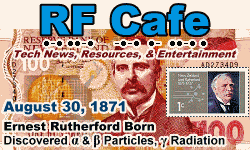|
  August 30 August 30
1844:
Francis Baily,
who studied the solar eclipse phenomenon of
Baily's Beads, died. 1871: British Nobel Prize winner
Sir Ernest Rutherford, who discovered alpha (α) and beta
(β) particles, as well as gamma (γ) radiation, was born. 1907:
John Mauchly, co-inventor of the
ENIAC computer, was born. 1914: The
first bombing of Paris by a German airplane occurred. 1928:
Wilhelm Carl
Werner Otto Fritz Franz Wien, who formulated the black body radiation displacement
law, died. 1929: General Electric delivered to
Colonel E.H. Green the first commercial hybrid auto that used
both gasoline and electric power. 1940:
Sir J.J. Thomson, who won a Nobel Prize for his work on cathode
rays, died. 1963: The
Hot Line communications link between the White House and the Kremlin became
operational. 1983:
Guion Bluford Jr. became the first black American astronaut to
travel in space, flying aboard the shuttle Challenger. 1985: My son, Philip, was
born - Happy Birthday! 1993: "The Late Show with David Letterman" premiered on CBS. 1994: The
largest U.S. defense contractor was created when the
Lockheed and
Martin Marietta
corporations agreed to a merger. 2004: Astronomer
Fred
Whipple, who proposed the "dirty snowball" model for comets, died.
| Jan
| Feb | Mar |
Apr | May |
Jun | Jul |
Aug | Sep |
Oct | Nov |
Dec |
Note: These
historical tidbits have been collected from various sources, mostly on the Internet.
As detailed in
this article, there
is a lot of wrong information that is repeated hundreds of times because most websites
do not validate with authoritative sources. On RF Cafe, events with
hyperlinks have been verified. Many years ago,
I began commemorating the birthdays of notable people and events with
special RF Cafe logos.
Where available, I like to use images from postage stamps from the country where
the person or event occurred. Images used in the logos are often from open source
websites like Wikipedia, and are specifically credited with a hyperlink back to
the source where possible.
Fair Use laws permit
small samples of copyrighted content.
|










